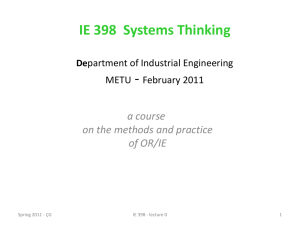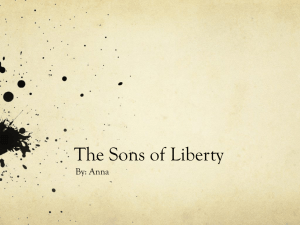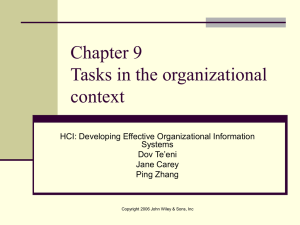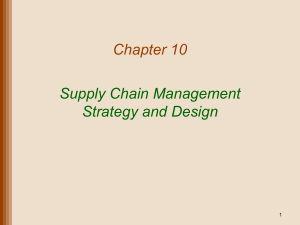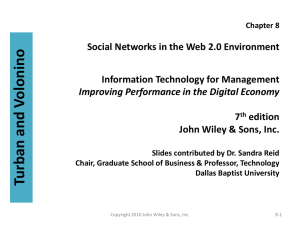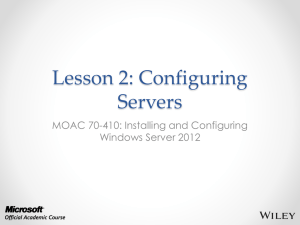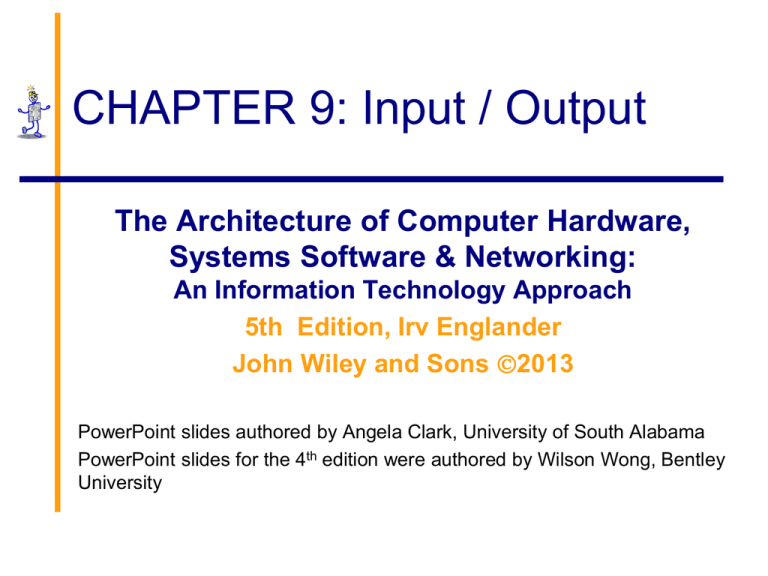
CHAPTER 9: Input / Output
The Architecture of Computer Hardware,
Systems Software & Networking:
An Information Technology Approach
5th Edition, Irv Englander
John Wiley and Sons 2013
PowerPoint slides authored by Angela Clark, University of South Alabama
PowerPoint slides for the 4th edition were authored by Wilson Wong, Bentley
University
Basic Model
Processing speed or program execution
Determined primarily by ability of I/O
operations to stay ahead of processor
Input
Process
Copyright 2013 John Wiley & Sons, Inc.
Output
9-2
I/O Requirements
Means for addressing different peripheral devices
A way for peripheral devices to initiate communication
with the CPU
An efficient means of transferring data directly between
I/O and memory for large data transfers since
programmed I/O is suitable only for slow devices and
individual word transfers
Buses that interconnect high-speed I/O devices with the
computer must support high data transfer rates
Capability of handling devices operating at varying
speeds with varying delays
Means for handling devices with extremely different
control requirements
Copyright 2013 John Wiley & Sons, Inc.
9-3
I/O Interfaces
Are necessary because of
Different formats required by the devices
Incompatibilities in speed between the
devices and the CPU that make
synchronization difficult
Bursts of data vs. streaming data
Device control requirements that would tie
up too much CPU time
Copyright 2013 John Wiley & Sons, Inc.
9-4
Examples of I/O Devices
Copyright 2013 John Wiley & Sons, Inc.
9-5
Simple I/O Configuration
Copyright 2013 John Wiley & Sons, Inc.
9-6
More Complex I/O Module
Copyright 2013 John Wiley & Sons, Inc.
9-7
Advanced I/O Techniques
Programmed I/O
CPU controlled I/O
Interrupt Driven I/O
External input controls
Direct Memory Access Controllers
Method for transferring data between main
memory and a device that bypasses the
CPU
Copyright 2013 John Wiley & Sons, Inc.
9-8
Programmed I/O
I/O data and address registers in CPU
One word transfer per I/O instruction
Address information for each I/O device
LMC I/O capability for 100 devices
Full instruction fetch/execute cycle
Primary use:
Keyboards
Communication with I/O controllers (see DMA)
Copyright 2013 John Wiley & Sons, Inc.
9-9
Programmed I/O Example
Copyright 2013 John Wiley & Sons, Inc.
9-10
Programmed I/O Example
Copyright 2013 John Wiley & Sons, Inc.
9-11
Interrupts
Signal that causes the CPU to alter its
normal flow of instruction execution
Frees CPU from waiting for events
Provides control for external I/O initiation
Examples
unexpected input
abnormal situation
illegal instructions
multitasking, multiprocessing
Copyright 2013 John Wiley & Sons, Inc.
9-12
Interrupt Terminology
Interrupt lines (hardware)
One or more special control lines to the CPU
Interrupt request
Interrupt handlers
Program that services the interrupt
Also known as an interrupt routine or device driver
Context
Saved registers of a program before control is
transferred to the interrupt handler
Allows program to resume exactly where it left off
when control returns to interrupted program
Copyright 2013 John Wiley & Sons, Inc.
9-13
Use of Interrupts
Notify that an external event has occurred
Real-time or time-sensitive
Signal completion
Printer ready or buffer full
Allocate CPU time
Time sharing
Indicate abnormal event (CPU originates for
notification and recovery)
Illegal operation, hardware error
Software interrupts
Copyright 2013 John Wiley & Sons, Inc.
9-14
The CPU – The Interrupt Cycle
Fetch / Execute cycle
Interrupt cycle
START
Fetch Next
Instruction
HALT
Execute
Instruction
Interrupts Disabled
Process
Interrupt
Copyright 2013 John Wiley & Sons, Inc.
Check for
Interrupt
9-15
Servicing the Interrupt
1. Lower priority interrupts are held until
higher priority interrupts are complete
2. Suspend program in progress
3. Save context, including last instruction
executed and data values in registers,
in the PCB or the stack area in
memory
4. Branch to interrupt handler program
Copyright 2013 John Wiley & Sons, Inc.
9-16
Servicing an Interrupt
Copyright 2013 John Wiley & Sons, Inc.
9-17
Print Handler Interrupt
Copyright 2013 John Wiley & Sons, Inc.
9-18
Using an Interrupt for Time Sharing
Copyright 2013 John Wiley & Sons, Inc.
9-19
Interrupt Processing Methods
Vectored interrupt
Address of interrupting device is included
in the interrupt
Requires additional hardware to implement
Polling
Identifies interrupting device by polling
each device
General interrupt is shared by all devices
Copyright 2013 John Wiley & Sons, Inc.
9-20
Vectored Interrupts
Copyright 2013 John Wiley & Sons, Inc.
9-21
Polled Interrupts
Copyright 2013 John Wiley & Sons, Inc.
9-22
Multiple Interrupts Example
Copyright 2013 John Wiley & Sons, Inc.
9-23
Direct Memory Access
Transferring large blocks of data
Direct transfer to and from memory
CPU not actively involved in transfer itself
Required conditions for DMA
The I/O interface and memory must be connected
The I/O controller must be capable of reading and
writing to memory
Conflicts between the CPU and the I/O controller
must be avoided
Interrupt required for completion
Copyright 2013 John Wiley & Sons, Inc.
9-24
DMA Instructions
Application program requests I/O service from
operating system
Privileged programmed I/O instructions
To initiate DMA, programmed I/O is used to
send the following information:
1.
2.
3.
4.
Location of data on I/O device
Starting location in memory
Size of the block
Direction of transfer: read or write
Interrupt to CPU upon completion of DMA
Copyright 2013 John Wiley & Sons, Inc.
9-25
DMA Initiation and Control
Copyright 2013 John Wiley & Sons, Inc.
9-26
I/O Controller Interfaces
Copyright 2013 John Wiley & Sons, Inc.
9-27
I/O Controller Functions
Recognizes messages from device(s) addressed to it
and accepts commands from the CPU
Provides a buffer where the data from memory can be
held until it can be transferred to the device
Provides the necessary registers and controls to
perform a direct memory transfer
Physically controls the device
Copies data from its buffer to the device/from the
CPU to its buffer
Communicates with CPU
Copyright 2013 John Wiley & Sons, Inc.
9-28
Copyright 2013 John Wiley & Sons
All rights reserved. Reproduction or translation of this
work beyond that permitted in section 117 of the 1976
United States Copyright Act without express permission
of the copyright owner is unlawful. Request for further
information should be addressed to the Permissions
Department, John Wiley & Sons, Inc. The purchaser
may make back-up copies for his/her own use only and
not for distribution or resale. The Publisher assumes no
responsibility for errors, omissions, or damages caused
by the use of these programs or from the use of the
information contained herein.
Copyright 2013 John Wiley & Sons, Inc.
9-29



